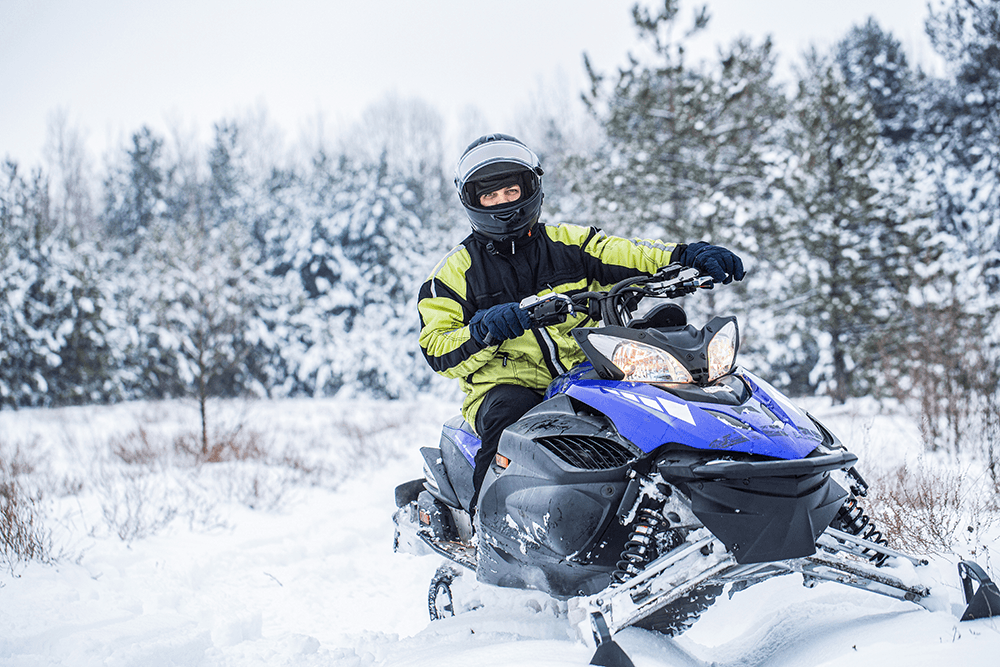
 Storage Tips
Storage TipsHow to Prepare A Snowmobile for Long Term Storage
Your snowmobile gives you incredible moments on the ski slopes and in the open snowfields. There's nothing like that rush you get when the cold wind is in your face and there's nothing but wild snowy terrain in front of you. Though you want these awesome moments to last forever, the snow will inevitably melt and you will need to store your snowmobile until the next season. To keep your snowmobile in good condition, you need to store it properly and protect its internal and external components. Here's how to summerize your snowmobile.
Clean and Wax the Snowmobile’s Exterior
Snowmobiles pick up plenty of salt, slush, mud, and water as they zip up and down the slopes. Though the trails are fun, these “souvenirs” can wear down the exterior of your vehicle and cause corrosion and rush. Use warm, soapy water and wipe down your snowmobile with a sponge. Clean under the hood and all the small details until it gleams. Use a pressure washer to clean off track, runners, and suspension. After the snowmobile dries, apply wax to improve its appearance and keep future stains and corrosion at bay.
Run the Engine Monthly, If Possible
If you plan to put your snowmobile in long-term storage, you’ll get the best results if you can check on it once a month. Ideally, you should turn on the snowmobile’s engine once a month and run it for a few minutes. If you can’t start the snowmobile monthly, you may fog the engine to keep it lubricated.
If your snowmobile is stored in a facility near a winter vacation home or one of your favorite ski slopes, it's understandable that this may not be feasible. However, if you can make the trip or hire someone to do the job for you, this will prevent any sediment from settling. Running the engine periodically also prevents the vehicle’s seals from drying out.
Take Care of the Fuel System
Experts recommend storing a newer model snowmobile with a full tank to decrease condensation risks. If water gets in the fuel system, it can malfunction at its next startup. Older models with a carburetor system should have their tanks drained. Before you proceed with gas tank care, read your manufacturer’s manual to find out the best practices.
To start the summerizing process for a newer model, fill the snowmobile’s tank and then add a fuel stabilizer. This product prevents the breakdown of gasoline solvents, which would otherwise corrode the system. If you see green residue at your vehicle’s winter restart, you forgot the fuel stabilizer.
Also, storing a snowmobile in a temperature-controlled environment with an air conditioner to decrease humidity helps a lot. Summer is known for its high levels of humidity, so having an air-conditioned place for your vehicle can make a big difference.
Care for Other Vital Components
Each snowmobile has a different set of recommended summerizing steps that are based on their unique components. Depending on the make, model, and year of your vehicle, you may need to do these additional steps before storage:
- Fog the engine to coat the inside with oil. This prevents engine failure by protecting it from moisture, corrosion, and humidity damage. This step is vital if you can’t visit your vehicle monthly and do a restart.
- Drain the carburetor to remove any excess fuel. If this fuel is left inside, it can evaporate and leave behind a residue that blocks conduits and corrodes metals.
- Grease and lubricate parts such as the chassis, suspension rails, exhaust, and nuts, but avoid the belts or clutch.
- Remove the battery before long-term storage. Batteries will drain if left in the vehicle. For the best results, place these parts in a temperature-controlled space. If you can, use a trickle charger to keep the battery charged. If the battery is older than 3 years, replace it.
- Remove the drive belt which can develop condensation between itself and the clutch. It will also rotate properly when it’s taken out to rest in an unrolled position instead of being stuck inside the snowmobile.
If possible, store your snowmobile in a raised position, such as on a pallet or snowmobile dolly. Then, cover your vehicle with a specialized snowmobile cover to further insulate it and protect its exterior from pests, UV rays, and more.
What Size Storage Unit Do I Need for My Snowmobile?
A 5×10 storage space is our most popular sized storage unit for snowmobiles. You’ll also have extra room to store your gear as well. Some people consider renting a 5×5 storage unit but it will be a very tight fit. To make sure you’re selecting the appropriately sized storage unit, we highly recommend you take a minute to measure.
How to Prepare Your Snowmobile for Storage
Your Snowmobile needs special care when putting it into storage. Use this checklist to make sure it’s ready for the first snowfall.
- Clean the Exterior: Wash and wax your snowmobile before placing it in storage. Make sure everything is dry to prevent rust.
- Change the Oil: Water in your oil can cause rust and corrosion on your engine. Be sure to change the filter and flush it out before adding oil.
- Flush Coolant System: Drain out the current coolant and flush the system. Next fill it with fresh antifreeze to prevent engine corrosion.
- Add Fogging Oil: If the engine is not diesel, use fogging oil to protect the carburetor and cylinders.
- Disconnect the Battery: Batteries will lose their charge when kept plugged in and in storage. Consider hooking it up to a battery tender. Just remember to disconnect it before you go for a ride.
- Loosen Drive Belts & Track Tension: When kept under constant tension, drive belts and track can crack or break. Loosen or remove them completely.
- Prevent Pests: During colder months pests look for places to take shelter. You can either place steel wool inside the exhaust port or place a cover over it.
- Add a Fuel Stabilizer: Fuel has a shelf life of about 3 to 4 months so make sure you add a fuel stabilizer to make it last longer. You may have to run your boat and repeat the process if you plan to store it for a long time.
- Inflate Dolly Tires: For extended storage periods, place it on a well inflated Snowmobile dolly. This will make it easier to move and keep it off the ground.
- Cover Your Snowmobile: Protect your Snowmobile from the elements as well as dirt & grime.
- Update Insurance: When it comes to insurance be sure that your coverage is updated to include Storage Rentals of America as the storage location.
Worry-Free Storage Solutions
There are a lot benefits of storing your snowmobile with Storage Rentals of America include:
- Clean, well-lit, and affordable interior storage units to suit your storage needs. From small engine vehicles to full size cars, we have storage units of all sizes.
- Short or long-term storage is available with money saving discounts. Stay longer and save!
- Safe and secure self-storage facilities guarded with electronic gate access and 24/7 video monitoring.
- Convenient storage locations in Delaware, Florida, Kentucky, New Jersey, Ohio, and South Carolina.
What Documentation is Required?
You’ll need to bring in three documents when you come in and rent with us. A government issued ID like a driver’s license or passport, vehicle registration, and proof of insurance. Check with your insurance provider to see if your policy covers storing your snowmobile in long term storage and bring in a copy.



